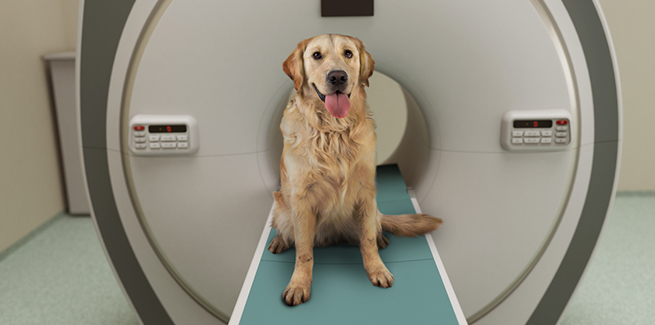A new noninvasive cancer-imaging technique could help in early detection

A groundbreaking cancer-imaging technique pioneered to diagnose human prostate cancer is being repurposed by researchers at Colorado State University (CSU) to diagnose canine cancer in dogs with head and neck tumors.
Morris Animal Foundation is funding the research, which would allow veterinarians to develop optimum treatment plans during cancer staging to maximize a patient’s chance for a positive outcome.
The technique involves injecting nanoparticles—in this case, microscopic bits of iron—into a dog’s bloodstream. The body’s immune system then engulfs the particles with white blood cells (macrophages) that clear blood of cellular debris before moving into nearby lymph nodes.
Iron appears black on an MRI, so a completely healthy lymph node full of nanoparticle-bearing macrophages would look black, too. But cancer cells push macrophages out of lymph nodes, so if cancer has invaded even a small portion of a lymph node, that portion would appear white on an MRI.
In an initial pilot study of a six-dog sample group, the technique demonstrated an 88% success rate in detecting cancer. Researchers plan to enroll 50 dogs with head and neck cancers for the next phase of testing.
NEWStat spoke to study lead researcher Lynn Griffin, DVM, MS, DACVR, DACVR (RO), an assistant professor of radiology at CSU’s College of Veterinary Medicine and Biomedical Sciences, to find out more.
NEWStat: What are the advantages of this new technique over current imaging techniques?
Lynn Griffin: A lot of the current imaging methods used to diagnose metastatic lymph nodes rely on the size of the lymph node (as palpated or as seen with various imaging modalities) or the contrast enhancement patterns that are relatively insensitive/inaccurate. There are a number of previous articles that have a reported sensitivity ranging from 12.5% up to almost 70%. Because we are exploiting more of a physiologic consequence of metastatic disease, this method seems to be more sensitive.
NEWStat: Right now you’re focusing on tumors in the head and neck. Why?
LG: We’re using head and neck tumors right now because to prove this method works, we have to extirpate the lymph nodes and have histology performed. This is a common practice for dogs with aggressive head and neck tumors with limited morbidity to the patient (versus if we were extirpating sublumbar lymph nodes, for example). There is also a significant number of head and neck tumors that we see at [CSU’s] Flint Animal Cancer Center, which makes accruing numbers easier.
NEWStat: What other applications might this technique have?
LG: Theoretically, because this is about how any lymph node functions, rather than just a specific type of tumor, we can move into other types of aggressive cancers such as oral squamous cell carcinoma in cats or anal sac adenocarcinoma in dogs and get similar results. In addition, we are looking into using these iron nanoparticles to image inflammation in tumors before and after stereotactic radiation therapy (SRT) in an attempt to characterize the immune response the body has to high dose per fraction radiation.
NEWStat: What’s next for your current research?
LG: We are going to be using these scans to develop some objective quantitative parameters to evaluate lymph nodes, rather than just looking at them and saying “are they metastatic, yes or no?” a method that would be more prone to observer error. We are also working on creating a truncated, less involved—and therefore less expensive—protocol that will make it more clinically applicable for other practices, not just research institutions. That’s pretty important to me, as I don’t see the point in spending all the money to create a new, better way to stage a patient [if] no one can afford to do it in their everyday practice.
NEWStat: And after you finish this study?
LG: We’re looking at the imaging of inflammation pre- and post-SRT with iron nanoparticles as well as using them to look at vascular density in tumors. It’s a really exciting, newly emerging area of research that I think is going to be very beneficial to understanding how the immune system plays a role in how our body works to either help or hinder cancer.
Photo credit: © iStock/MediaProduction



